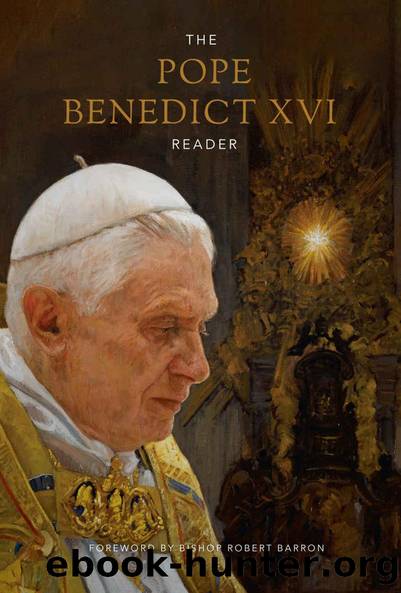The Pope Benedict XVI Reader by Pope Benedict XVI

Author:Pope Benedict XVI [Benedict XVI, Pope]
Language: eng
Format: epub
Publisher: Word on Fire Institute
Published: 2021-04-15T16:00:00+00:00
Chapter 26:
The Eucharist and the Sacraments of Mission
Written at the conclusion of the 2005 Synod on the Eucharist, Benedict XVIâs apostolic exhortation Sacramentum Caritatis (The Sacrament of Charity) discusses the central place of the Eucharist in the life of the Church. In the following excerpt, Benedict XVI explains the relationship of the Eucharist to the two sacraments of mission: Holy Orders and Matrimony.
The Eucharist and the Sacrament of Holy Orders
In persona Christi capitis
The intrinsic relationship between the Eucharist and the sacrament of Holy Orders clearly emerges from Jesusâ own words in the Upper Room: âDo this in memory of meâ (Luke 22:19). On the night before he died, Jesus instituted the Eucharist and at the same time established the priesthood of the New Covenant. He is priest, victim, and altar: the mediator between God the Father and his people (cf. Heb. 5:5â10), the victim of atonement (cf. 1 John 2:2, 4:10) who offers himself on the altar of the Cross. No one can say âthis is my bodyâ and âthis is the cup of my bloodâ except in the name and in the person of Christ, the one high priest of the new and eternal Covenant (cf. Heb. 8â9). Earlier meetings of the Synod of Bishops had considered the question of the ordained priesthood, both with regard to the nature of the ministry49 and the formation of candidates.50 Here, in the light of the discussion that took place during the last Synod, I consider it important to recall several important points about the relationship between the sacrament of the Eucharist and Holy Orders. First of all, we need to stress once again that the connection between Holy Orders and the Eucharist is seen most clearly at Mass, when the Bishop or priest presides in the person of Christ the Head.
The Church teaches that priestly ordination is the indispensable condition for the valid celebration of the Eucharist.51 Indeed, âin the ecclesial service of the ordained minister, it is Christ himself who is present to his Church as Head of his Body, Shepherd of his flock, High Priest of the redemptive sacrifice.â52 Certainly the ordained minister also acts âin the name of the whole Church, when presenting to God the prayer of the Church, and above all when offering the eucharistic sacrifice.â53 As a result, priests should be conscious of the fact that in their ministry they must never put themselves or their personal opinions in first place, but Jesus Christ. Any attempt to make themselves the center of the liturgical action contradicts their very identity as priests. The priest is above all a servant of others, and he must continually work at being a sign pointing to Christ, a docile instrument in the Lordâs hands. This is seen particularly in his humility in leading the liturgical assembly, in obedience to the rite, uniting himself to it in mind and heart, and avoiding anything that might give the impression of an inordinate emphasis on his own personality. I encourage the clergy always to see their eucharistic ministry as a humble service offered to Christ and his Church.
Download
This site does not store any files on its server. We only index and link to content provided by other sites. Please contact the content providers to delete copyright contents if any and email us, we'll remove relevant links or contents immediately.
Resisting Happiness by Matthew Kelly(3265)
The Social Psychology of Inequality by Unknown(2901)
Day by Elie Wiesel(2689)
Designing Your Life by Bill Burnett(2621)
The Giving Tree by Shel Silverstein(2214)
Angels of God: The Bible, the Church and the Heavenly Hosts by Mike Aquilina(1901)
Human Design by Chetan Parkyn(1884)
The Supreme Gift by Paulo Coelho(1856)
Jesus of Nazareth by Joseph Ratzinger(1741)
Augustine: Conversions to Confessions by Robin Lane Fox(1711)
Hostage to the Devil by Malachi Martin(1708)
7 Secrets of Divine Mercy by Vinny Flynn(1655)
Dark Mysteries of the Vatican by H. Paul Jeffers(1638)
The Vatican Pimpernel by Brian Fleming(1616)
St. Thomas Aquinas by G. K. Chesterton(1582)
Saints & Angels by Doreen Virtue(1553)
The Ratline by Philippe Sands(1464)
My Daily Catholic Bible, NABRE by Thigpen Edited by Dr. Paul(1442)
Called to Life by Jacques Philippe(1429)
